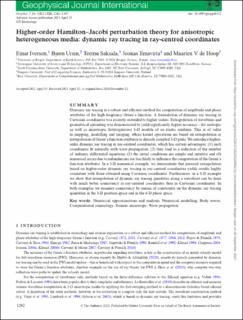| dc.contributor.author | Iversen, Einar | |
| dc.contributor.author | Ursin, Bjørn | |
| dc.contributor.author | Saksala, Teemu | |
| dc.contributor.author | Ilmavirta, Joonas | |
| dc.contributor.author | V. de Hoop, Maarten | |
| dc.date.accessioned | 2021-11-19T09:01:58Z | |
| dc.date.available | 2021-11-19T09:01:58Z | |
| dc.date.created | 2021-11-18T17:16:05Z | |
| dc.date.issued | 2021 | |
| dc.identifier.issn | 0956-540X | |
| dc.identifier.uri | https://hdl.handle.net/11250/2830415 | |
| dc.description.abstract | Dynamic ray tracing is a robust and efficient method for computation of amplitude and phase attributes of the high-frequency Green’s function. A formulation of dynamic ray tracing in Cartesian coordinates was recently extended to higher orders. Extrapolation of traveltime and geometrical spreading was demonstrated to yield significantly higher accuracy—for isotropic as well as anisotropic heterogeneous 3-D models of an elastic medium. This is of value in mapping, modelling and imaging, where kernel operations are based on extrapolation or interpolation of Green’s function attributes to densely sampled 3-D grids. We introduce higher-order dynamic ray tracing in ray-centred coordinates, which has certain advantages: (1) such coordinates fit naturally with wave propagation; (2) they lead to a reduction of the number of ordinary differential equations; (3) the initial conditions are simple and intuitive and (4) numerical errors due to redundancies are less likely to influence the computation of the Green’s function attributes. In a 3-D numerical example, we demonstrate that paraxial extrapolation based on higher-order dynamic ray tracing in ray-centred coordinates yields results highly consistent with those obtained using Cartesian coordinates. Furthermore, in a 2-D example we show that interpolation of dynamic ray tracing quantities along a wavefront can be done with much better consistency in ray-centred coordinates than in Cartesian coordinates. In both examples we measure consistency by means of constraints on the dynamic ray tracing quantities in the 3-D position space and in the 6-D phase space. | en_US |
| dc.language.iso | eng | en_US |
| dc.publisher | Oxford University Press | en_US |
| dc.subject | Seismologi | en_US |
| dc.subject | Seismology | en_US |
| dc.subject | Anvendt geofysikk | en_US |
| dc.subject | Applied geophysics | en_US |
| dc.subject | Bølgeteori | en_US |
| dc.subject | Wave theory | en_US |
| dc.title | Higher-order Hamilton–Jacobi perturbation theory for anisotropic heterogeneous media: dynamic ray tracing in ray-centred coordinates | en_US |
| dc.type | Journal article | en_US |
| dc.type | Peer reviewed | en_US |
| dc.description.version | publishedVersion | en_US |
| dc.rights.holder | Copyright 2021 the authors | en_US |
| cristin.ispublished | true | |
| cristin.fulltext | original | |
| cristin.qualitycode | 2 | |
| dc.identifier.doi | 10.1093/gji/ggab152 | |
| dc.identifier.cristin | 1956118 | |
| dc.source.journal | Geophysical Journal International | en_US |
| dc.source.pagenumber | 1262-1307 | en_US |
| dc.subject.nsi | VDP::Faste jords fysikk: 451 | en_US |
| dc.subject.nsi | VDP::Solid earth physics: 451 | en_US |
| dc.identifier.citation | Geophysical Journal International. 2021, 226 (2), 1262-1307. | en_US |
| dc.source.volume | 226 | en_US |
| dc.source.issue | 2 | en_US |
